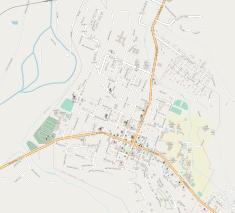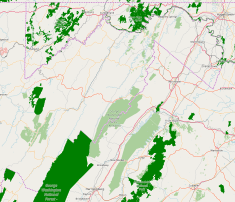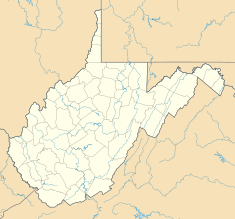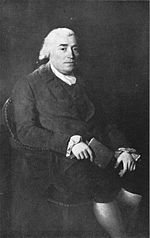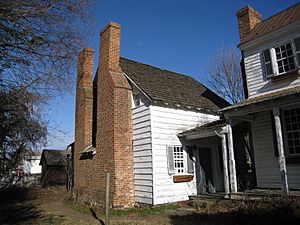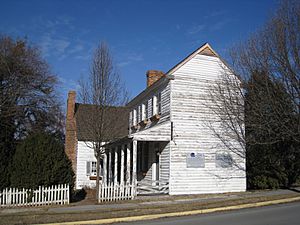Wilson-Wodrow-Mytinger House facts for kids
Quick facts for kids |
|
|
Wilson-Wodrow-Mytinger House
|
|
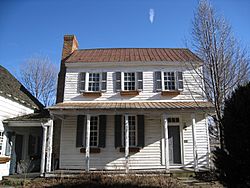
The clerk's office (1780s) of the Wilson-Wodrow-Mytinger House
|
|
| Location | 51 West Gravel Lane Romney, West Virginia, United States |
|---|---|
| Area | 1 acre (0.40 ha) |
| Built | (c. 1740s–c. 1780s) Kitchen structure (c. 1750) Clerk's office (1780s) |
| Architectural style | American colonial architecture |
| NRHP reference No. | 77001375 |
| Designated | August 22, 1977 |
The Wilson-Wodrow-Mytinger House is an 18th-century complex of three structures, built between the 1740s and 1780s, in Romney, West Virginia. The clerk's office, dating from the 1780s, is the oldest surviving government office building in West Virginia. The kitchen building (c. 1750) is the oldest remaining component of the Wilson-Wodrow-Mytinger House and the oldest building in Romney. Throughout the course of its history, the Wilson-Wodrow-Mytinger House has been known as the Andrew Wodrow House, the Mytinger Family Home, and the Mytinger House.
The earliest recorded person residing on Lot Number 48 in Romney was Hugh Murphy. In 1763, Colonel George William Wilson received a patent to Lot Number 48 from Thomas Fairfax, 6th Lord Fairfax of Cameron, to purchase the lot from Murphy. Wilson served as a major of the Hampshire County militia during the French and Indian War. He relocated to Pennsylvania, and in 1770, George Washington spent the night in a log cabin on the northeastern corner of Lot Number 48. Andrew Wodrow arrived in Hampshire County during the latter phase of the American Revolutionary War, or shortly after its close, and in 1782, he was named clerk of court for Hampshire County. Wodrow completed the clerk’s office building in the 1780s, and the complex assumed its current configuration by 1790.
Wodrow served as Clerk of Court for Hampshire County until his death in 1814, after which ownership passed to Wodrow’s son-in-law John McDowell, a Dr. McClinoch, and the Mytinger family who retained the property for about 100 years. Manning H. Williams purchased the house and restored it in 1962. Dr. Herbert P. Stelling purchased the Wilson-Wodrow-Mytinger House in 1973, and it opened as a museum and an arts and handicrafts shop known as Colonial Craftsmen. While under the Stelling family's ownership, the house was listed on the National Register of Historic Places in 1977. Its current owners, Old Hampshire Ltd., purchased the Wilson-Wodrow-Mytinger House in 1985.
Contents
Geography and setting
The Wilson-Wodrow-Mytinger House property is at 51 West Gravel Lane near the center of Romney, West Virginia, within the eastern section of town Lot Number 48 and the western section of Lot Number 58. Taggart Hall, a late 18th-century residence, is located to the property's immediate east, and serves as the headquarters for the Fort Mill Ridge Foundation, the Hampshire County Convention and Visitors Bureau, and the Hampshire County Chamber of Commerce. Across West Gravel Lane to the immediate south of the Wilson-Wodrow-Mytinger House is the parking lot of the Romney Volunteer Fire Department, which was formerly the location of the town's Old Presbyterian Church and Cemetery on Lots No. 59 and 60.
History
Background
The land upon which the Wilson-Wodrow-Mytinger House is located was originally part of the Northern Neck Proprietary, a land grant that the exiled Charles II awarded to seven of his supporters in 1649 during the English Interregnum. Following the Restoration in 1660, Charles II finally ascended to the English throne. He renewed the Northern Neck Proprietary grant in 1662, revised it in 1669, and renewed the original grant favoring original grantees Thomas Colepeper, 2nd Baron Colepeper, and Henry Bennet, 1st Earl of Arlington, again in 1672. In 1681 Bennet sold his share to Lord Colepeper, who received a new charter for the entire land grant from James II in 1688. Following the deaths of Lord Colepeper, his wife Margaret, and his daughter Katherine, the Northern Neck Proprietary passed to Katherine's son Thomas Fairfax, 6th Lord Fairfax of Cameron, in 1719.
The area surrounding present-day Romney remained sparsely populated by European settlers until the middle of the 18th century, when tensions with Native Americans began to subside. Around this time, Lord Fairfax wanted to have the lands of his Northern Neck Proprietary used and enticed European settlers to move there. His initiative led to the establishment of population centers, such as Romney. After Lord Fairfax settled at Greenway Court near Winchester, Virginia, he oversaw the sale and settling of his proprietary lands. One of his surveyors, George Washington, noted in 1748 that a number of people were living in the vicinity of present-day Romney. County records indicate that Lord Fairfax began selling land within present-day Hampshire County in 1749. However, the name of the first person to own or build on the lot on which the Wilson-Wodrow-Mytinger House stands is not currently known. By 1754, Hampshire County was formed from parts of Frederick and Augusta counties.
Gravel Lane, the present-day street where the Wilson-Wodrow-Mytinger House is located, is aligned to an old trail used by Native Americans prior to the arrival of European settlers. Gravel Lane was Romney's original main street, and according to the Federal Writers' Project in its Historic Romney 1762–1937 (1937), Gravel Lane "is the most historic lane in the town—and perhaps in the Northern Neck".
Wilson family
The earliest known person to own Lot Number 48, on which the Wilson-Wodrow-Mytinger House is located, was Hugh Murphy. In 1763, Colonel George William Wilson received a patent to Lot Number 48 from Lord Fairfax and purchased it from Murphy. Wilson arrived in Romney sometime between 1761 and 1763. According to a report by George Washington to the Virginia House of Burgesses in November 1764, Wilson served as a major of the Hampshire County militia during the French and Indian War. Washington praised him for his earnestness and courage. Wilson's residency in Romney was brief, and sometime between 1764 and 1768, he relocated to Pennsylvania.
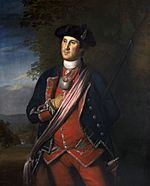
On October 9, 1770, George Washington purportedly stayed the night in an old log house at the northeastern corner of Lot Number 48. This was his final visit to Romney. In his diary, Washington wrote:
Went up to Rumney in order to buy work Horses, and meet Doctr. Craik and my Baggage; arrivd there abt. 12, distance 16 Miles. In the Afternoon Doctr. Craik and my Servt. and the Baggage, arrivd from Pritchard's; said to be 28 Miles.
Having purchasd two Horses, and recoverd another which had been gone from me near 3 Years, I dispatchd my boy Giles with my two Riding Horses home, and proceeded on my journey;...
Wilson became a justice of the peace for newly established Bedford County, Pennsylvania, in 1771. He was involved in the Pennsylvania–Virginia boundary dispute, and was also selected by the Pennsylvanian faction at Fort Pitt to supervise the election of delegates to the constitutional convention from Pennsylvania. He encouraged support for the American Revolution and became the lieutenant colonel of the 8th Pennsylvania Regiment during the American Revolutionary War. He died from an illness during the regiment's march to join Washington in New Jersey in January 1777. Wilson's daughter Mary Ann married Andrew Wodrow, and following Wilson's death, the Wilson-Wodrow-Mytinger House passed to his son-in-law Wodrow.
Wodrow family
Andrew Wodrow was born in Scotland, possibly in Glasgow, in 1752. He was descended from a family of scholars and professors. His father Robert Wodrow was a historian of the Church of Scotland with a "national reputation" and published his history in 1752, the same year as Wodrow's birth. Wodrow immigrated to the Colony of Virginia in 1768. During the 1770s, he established and expanded what became a thriving import business in Fredericksburg. Following the outbreak of the American Revolutionary War, he abandoned his business rather than import and sell goods from the Kingdom of Great Britain. Following the cessation of his import business, Wodrow was appointed to serve in the political post of clerk for the Revolutionary Committee for King George County on May 6, 1775. He arrived in Hampshire County during the latter phase of the American Revolutionary War or shortly after it ended, and in 1782, he was named clerk of court for Hampshire County. Although he was the third person to hold this office, Wodrow was the first clerk to reside in the county.
As a key official, Wodrow played an important role in the conveying and settling of lands and was a prosperous landholder in his own right. He is credited with giving the Wilson-Wodrow-Mytinger House complex its current form. He completed the grouping of the three sections of the Wilson-Wodrow-Mytinger House and his association with the property lent the complex significance for its listing in the National Register of Historic Places (NRHP). In the 1780s, Wodrow built the frame structure (the last of the house's three structures) on the property for use as a clerk's office. At that time, Gravel Lane was Romney's main street and the function and architectural beauty of the clerk's office made it a center of activity in the town. According to West Virginia Antiquities Commission research assistant Phillip R. Pitts and historian James E. Harding, the clerk's office "might have served as a sign that [the Romney community] was developing in a manner indicative of the end of a frontier existence and the start of an established position". By the beginning of the 19th century, Romney and Hampshire County had become a settled area with an agriculturally based economy that maintained a fairly constant growth.
By 1790, the three structures constituting the Wilson-Wodrow-Mytinger House probably assumed their present arrangement. The trustees of the Town of Romney commissioned John Mitchel to draft a cadastral survey map of Romney in 1790. Prior to this survey, Thomas Fairfax, 6th Lord Fairfax of Cameron, had commissioned a similar cadastral survey of the town sometime before its incorporation on December 23, 1762. On June 30, 1790, Mitchel submitted to the trustees a "Plan of the Town of Romney" that divided the town into 100 land lots of equal size, including the two lots on which the Wilson-Wodrow-Mytinger House was located (Lots Number 48 and 58).
Wodrow remained in his post as clerk of court for Hampshire County until his death in 1814. Successive owners included Wodrow's son-in-law John McDowell, Dr. McClinoch who was one of Romney's first physicians, and the Mytinger family, in whose hands the property remained for about 100 years.
Mytinger family
Tobias Mytinger acquired the Wilson-Wodrow-Mytinger House property in 1861. Mytinger family members owned the house for almost 100 years, the longest period of the owning families. Manning H. Williams purchased the house from the Mytinger family in 1959.
Williams family and restoration
Efforts to restore the Wilson-Wodrow-Mytinger House complex began in 1962 while it was under the ownership of Manning H. Williams. Until that time, much of the structures' original building materials and architectural details remained extant, although in a state of deterioration. Modern conveniences, including electricity, plumbing, and a central heating system, had not been installed. The restoration project began with the clerk's office in June 1962. During its restoration, the structure's doors, woodwork, stairs, floors, and most of its plaster were retained. Replicas of the second-story windows were fabricated, and old glass was collected from around the area and placed in their wooden sashes. Some of the structure's weatherboards were also replaced, and then the exterior of the clerk's office was painted white. Ceilings with radiant electric heating were installed, and insulation was added between the walls. When painting the structure's walls and woodwork, a concerted effort was made to duplicate the original or period paint colors.
The residential structure, also known as "the dwelling," required more extensive rehabilitation. Its floor beams were completely rebuilt, its rafters replaced, and a new roof of red cedar (Juniperus virginiana) roof shingles was installed. Much of the brickwork of its double chimneys had to be repaired. A section of the interior eastern wall of the largest first floor room was removed to unmask the half-timber construction, and another section was opened to expose the hand-riven lath. Having been protected by the porch, some of the original siding on the structure's northern side was kept; replacement siding was duplicated for the remainder of the exterior and painted white.
The rear kitchen building was cleaned, repaired, and covered with new weatherboards, both its interior and exterior were painted white, and it was topped with cedar shakes. All the surrounding porches were rebuilt and roofed with cedar shingles, a brick walk was placed along the western (front) side of the clerk's office and around the residential structure to the rear of the property, and a white picket fence was built around the property.
Stelling family and Colonial Craftsmen
Dr. Herbert P. Stelling of Barre, Massachusetts, purchased the Wilson-Wodrow-Mytinger House in May 1973, and in October it was opened as a museum and an arts and handicrafts shop known as Colonial Craftsmen. Stelling's daughters Rebecca, Deborah, and Rhetta Stelling, and Gary Winkles operated the museum and store. Colonial Craftsmen featured demonstrations of old craft skills and the sale of traditional craftsmen's wares.
While under Stelling family ownership, the Wilson-Wodrow-Mytinger House was listed in the National Register of Historic Places (NRHP) on August 22, 1977—only the second historic property in Hampshire County to be listed after the Sloan–Parker House.
Old Hampshire, Ltd.
Old Hampshire, Ltd., Bob and Estelle Odle, Tom Stump, Lowell Hott, and Dottie Eddis, purchased the Wilson-Wodrow-Mytinger House in October 1985. Hott and Eddis originally planned to convert the complex into a bed and breakfast; however, since 1988, they have utilized the residential house as the Romney satellite office for their Augusta Animal Hospital veterinary clinic. Hott and Eddis have continued to maintain and restore the house, and have completed large construction projects, including a renovation of the kitchen building's crumbling stone chimney and a replacement of the roof's shingles from the 1962 restoration in December 2019. In a 2019 interview with the Hampshire Review regarding their continued maintenance and restoration of the property, Hott remarked, "It's really been a labor of love for us."
Old Presbyterian Church and Cemetery
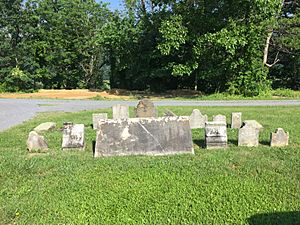
Immediately south of the Wilson-Wodrow-Mytinger House, across East Gravel Lane, is the former location of Romney's Old Presbyterian Church and Cemetery. They were associated with the house, as Andrew Wodrow was a dynamic and influential member of the Presbyterian Church and granted Lots No. 59 and 60 in his will for the construction of the church and the establishment of the cemetery. On April 1, 1816, Wodrow's executor, James Dailey, deeded the two lots on to Mount Bethel Congregation trustees James Beach, William Inskeep, Adam Hare, and John Lawson for these purposes. Wodrow was interred in this cemetery located atop the lots' hill. The Presbyterian church was built near the corner of West Gravel Lane and South High Streets between 1812 and 1816. The Old Presbyterian Cemetery fell into neglect by the late 19th century and was destroyed around 1940 when the hill on which it was located was cut away and leveled for the construction of a factory. Although some human remains and headstones were relocated to Indian Mound Cemetery, Wodrow's remains were likely lost during the destruction of the cemetery.
Architecture
The Wilson-Wodrow-Mytinger House is a complex composed of three independent structures varying in size, type of construction, building orientation, and purpose. Architectural historian S. Allen Chambers characterized the complex as, "a charmingly informal assemblage" and "wonderfully forthright". The three component structures were built between the 1740s and the 1780s, and consist of the one and one-half-story kitchen structure (c. 1750), the one and one-half-story residential structure, and the two and one-half-story clerk's office (1780s). The kitchen structure is the rear (northern) component of the Wilson-Wodrow-Mytinger House, the residential structure is the middle component, and the clerk's office is located to the front (southern end) of the property along West Gravel Lane. The three structures are positioned near one another and connected by one-story porches throughout most of their existence, which have facilitated their use as a single building. According to West Virginia Antiquities Commission research assistant Phillip R. Pitts and historian James E. Harding, the Wilson-Wodrow-Mytinger House represents "a sophistication in building style and design that was unusual, if not unique, in the frontier environment of the area during the second half of the eighteenth century". Pitts and Harding added that the architecture of the three contributing structures is "representative of a time period spanning much of the early history and development of Romney and what is now eastern West Virginia".
Kitchen structure (c. 1750)
The rear (northern) structure of the house dates from around 1750, and is thought to be the oldest extant building on the property and in Romney. It is believed to have been a kitchen for most of its existence. The kitchen structure is one and one-half stories in height and measures 14 feet (4.3 m) by 16 feet (4.9 m). Constructed of hand-hewn logs, its exterior is sheathed in white-painted, beaded weatherboard siding, and its gable roof is topped by red cedar (Juniperus virginiana) roof shingles. The kitchen structure is accessible by a single entryway on its southern façade, connected to the adjacent residential structure of the house by a covered porch. A large stone chimney dominates the kitchen structure's northern side, directly opposite the entryway on its southern side. One single six-over-three-light wooden sash window is set in the center of each of the building's long sides on the ground floor, and two four-light wooden sash windows are located in the southern gable opposite the fireplace to provide light to the upper story. An enclosed stairway provides access to the upper story and is situated opposite the fireplace side of the building. The interior walls of the kitchen structure are painted white. Between 2009 and 2014, the kitchen building's stone chimney began to crumble, and it was rebuilt using some of the original stones. The cedar shingles from the 1962 restoration were replaced in December 2019.
Residential structure
The residential structure or "the dwelling" of the house is located immediately in front of the rear kitchen structure. The residential structure is one and one-half stories in height and measures 24 feet (7.3 m) by 20 feet (6.1 m). It is built of frame construction with brick nogging (brick infill), and its exterior is sheathed in white-painted, beaded weatherboard siding. A gable roof tops the structure. Its exterior is symmetrically arranged, except for the prominent double brick chimneys on its western side, connected by a chimney pent on the ground floor. Central entryways are positioned on both the rear (northern) and front (southern) façades, with six-over-six-light wooden sash windows positioned on either side of each respective doorway. The upper level is illuminated by wooden sash windows located in both its east and west gables. The two windows on the western gable with the double chimneys are small four-light wooden sash windows, and the two windows on the eastern gable are six-over-six-light wooden sash windows.
The residential structure consists of four rooms: two traverse the ground level lengthwise and two traverse the upper level lengthwise. The front room on both the ground and upper levels is long and narrow. The double chimneys on the structure's western side allow for fireplaces in each of the four rooms. The western fireplace walls in each of the four rooms are enveloped by raised wooden paneling. West Virginia Antiquities Commission research assistant Phillip R. Pitts and historian James E. Harding note that the raised-panel fireplace walls "give the building a far more residential quality than the log structure behind it". The raised paneling of the western walls is modest in design and includes a chimney pent closet flanking the left side of the segmental-arched fireplace opening in each of the four rooms. A bolection molding frames the fireplace opening, however, there is no mantel shelf. A simple cornice with a cavetto molding runs the length of the raised paneling. Except for the fireplace wall, the interior walls of the ground-floor rooms are made of painted plaster, and the second-floor rooms' walls are made of painted flush boards. The structure's upper level is accessed by an enclosed stairway along the eastern wall of the larger rear rooms opposite the paneled fireplace walls.
According to Pitts and Harding, the architectural style and construction pattern of the residential structure were similar to buildings in Tidewater Maryland, built in the period before 1730. They stated that regardless of the structure's origin, it would have been "an expensive and pretentious structure" for the Romney area during that period. The half-timber construction with brick nogging, the double brick chimneys with a connecting chimney pent, and the medieval floor plan are features generally not associated with present-day West Virginia. The residential structure was possibly built for Lord Fairfax or his land agent. However, it is not known whether the kitchen structure was a preexisting pioneer home or a contemporary kitchen. Pitts and Harding theorized that if Lord Fairfax constructed the residential structure, he did so "to encourage development of the area by emphasizing that the Indian menace had abated and the location was suitable to a settled and prosperous existence".
Clerk's office (1780s)
The largest and most imposing structure contributing to the Wilson-Wodrow-Mytinger House complex is the two and one-half-story "clerk's office". This building is the oldest extant public office building in the state of West Virginia. Built of wooden frame construction, it measures 14 feet (4.3 m) by 26 feet (7.9 m), with its southern gable facing perpendicular toward Gravel Lane and its main entryway positioned on the structure's western (front) elevation. Both the front (western) and rear (eastern) façades are three bays wide, with nine-over-nine-light wooden sash windows in the ground-floor bays, and six-over-six-light wooden sash windows in the second-floor bays. The symmetry of the front façade's windows is interrupted by the main entryway in the most southern of the three bays, which is spaced slightly further to the right of the above bay. The structure's main façade is adjoined with a one-story shed-roofed porch supported by chamfered wooden columns. On the structure's eastern façade, the six bays are symmetrically placed with three six-over-six-light wooden sash windows on the second story and three nine-over-nine-light wooden sash windows on the ground floor.
According to Pitts and Harding, the placement of the window bays and the front entryway bay are "a rather sophisticated indication of the interior room arrangement". Each of the structure's floors is divided between a large room and a narrow stair hall (in a side-hall plan), which connects the two stories by an open dog-leg stairway. The large room on each floor has a paneled fireplace wall on its northern end. On the first floor of the clerk's office, the segmental-arched fireplace opening is bordered by a single crossette architrave. Pitts and Harding describe the wooden paneling on the fireplace wall as being "exceptional". The fireplace mantel's shelf support exhibits moldings identical to the cornice, including a "wall of Troy" motif. Fluted pilasters separate the fireplace wall into three sections. They consist of the segmental-arched fireplace with mantelpiece and the end segments of raised wooden paneling on either side of the fireplace. On the second floor, the wooden paneling is more simple in design, and the fireplace wall is divided into three segments with raised wooden panels. Only a mantelpiece containing a "wall of Troy" motif and a cornice with dentils adorn the fireplace wall. The other interior walls within the clerk's office structure are painted plaster.
Old log house
The Wilson-Wodrow-Mytinger House property formerly contained an old log house where George Washington purportedly stayed in 1770 during his final visit to Romney. The house stood at the northeastern corner of Lot Number 48 until it was demolished in 1932.


